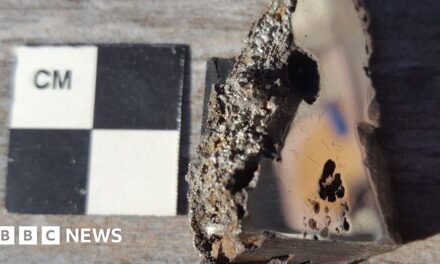
When Ancient Rome Meets Minimalism
One understandable reaction to spending more time at home is to stockpile objects meant to provide comfort. Probably even dedicated minimalists have pondered, as of late, what another throw or accent pillow might do for their space and mental state. But, while he is certainly not averse to an elegant sort of ease, Norbert Stumpfl, the executive design director of the Italian men’s wear label Brioni, has always put a great deal of time and care into his aesthetic choices, with results that are so precise as to feel inevitable. This is apparent from his clothing collections, consisting of expertly tailored, handmade suits and separates in luxurious wools and silks — and from the three-story, 3,200-square-foot townhouse in central Rome where the Austria-born designer, 44, lives with his wife, Daphne Karras, a ceramist, and their two daughters.
Before the family left Paris and started renting the house in 2019, its owners finished a multiyear renovation, updating the space with elements such as stainless-steel beams, concrete and glass flooring and, on the upper levels, floor-to-ceiling windows. This means that, while the bones of the house are quintessentially Roman — the foundation may date as far back as the 8th century B.C., and remnants of ancient walls, as well as a simple white tile mosaic near the entrance on the ground floor, are still visible — it gets a surprising amount of light for this quiet side street, which also features a medieval monastery. And so the new tenants had a bright and pleasingly clean-lined canvas, but one steeped in history. “It’s a beautiful mix of ancient Rome and very modern minimalism,” says Stumpfl. It’s also a combination perfectly complemented by his approach to the interiors, which is defined by respect for both age-old processes and fresh, pared-down forms, and by an emphasis on materiality. As he says, “I only buy pieces I want to live with forever, and everything we have is soft and timeless and about technique.”
From the street, an ivy-covered wall conceals the building’s stone facade, which is partially painted a golden yellow. Guests walk through an iron gate and up a dark and narrow travertine marble stairwell, where they find a 2,300-square-foot courtyard filled with wisteria, camellias and orange, lemon and strawberry trees and, just beyond, the front door. Beyond that is a large open-plan space — atypical for traditional Italian homes, which are more likely to have many little rooms and possibly one grand and gilded ballroom — that includes the kitchen, with a dome-shaped wood-burning brick oven and an exposed ancient wall whose shelves are lined with Karras’s ceramics (earth-toned bowls and vases with high-gloss finishes) — and the dining area. There, an oval wood table is surrounded by six leather and chrome vintage Butterfly chairs by the 20th-century Danish architect Arne Jacobsen that Stumpfl found in Brussels. (“I travel quite a bit to buy pieces I really love,” he says.) Hidden beneath them and a naturally dyed Moroccan rug are glass floor panels that offer a bird’s-eye view of the cellar. “That’s where my wife keeps her pottery studio, so you can just lift the carpet and say hello,” says Stumpfl, or, as the couple’s daughters like to do, fog up the surface and then draw abstract shapes and messages on it with their fingers. The house’s wooden coffered ceiling beams, which were installed over a century ago when the building belonged to the family of a woodworker whose shop was on the ground floor, also lend a bit of coziness.
Up a flight of curved concrete stairs are two living rooms, one with a pair of modern white linen Ghost sofas by the Italian design group Gervasoni, a streamlined 1950s wooden sideboard by the French designer Gérard Guermonprez that opens and closes with a push of a discrete button, and a beehive-like white table lamp made from superimposed metal discs by the Finnish designer Ilmari Tapiovaara in 1955. This more formal space, Stumpfl says, is “to sit in,” while the other, with wooden shelves stacked with art and architecture books and black office binders filled with magazine clippings, as well as a pair of chairs and two blankets, is “to live in.”
Both, though, are adorned with art, including a silver-plated sculpture by Fritz Nagel that sits atop a Marcel Breuer wood-and-steel Laccio table, a 1966 limited-edition lithograph of a magnolia by Ellsworth Kelly, a black ceramic sculpture by Antoine Tarot and photographs from Rinko Kawauchi’s 2011 “Illuminance” series. The family spends a lot of time around the ’70s-era vintage metal-and-glass coffee table in the living living room, whether they’re reading or playing with clay knickknacks made by Danae, 10, and Thea, 7, though the girls have full run of the house. In the sitting room, there’s a piece that, at first glance, looks like a fragile abstract sculpture; in fact, it’s a Tangle, an American children’s toy meant to twist and stretch into any shape imaginable. “It’s first a family home,” says Stumpfl.
Other accents exist in the form of plants, five of which fill the back of the sitting room, which features a glass ceiling and a spiral steel-and-glass staircase that leads to the three bedrooms on the top level. In the afternoon light, the stairwell becomes a prism and rainbows fill the space. “We treat it as a kind of greenhouse,” says Stumpfl, who finds his ficus tree and night-blooming cereus, which produces small white flowers that each lasts for one day and one night before falling off, to be calming presences. There’s also a strelitzia, or bird of paradise, with its black beak-like blooms, that sits atop a rectangular pedestal and within a terra-cotta pot that resembles a stack of pebbles made by the artist Francesco Del Re, who’s based outside of Florence. “Instead of a red tone, he’s using gray-colored earth, and while the handmade process is traditional, the shapes are modern,” says Stumpfl. “It’s sophisticated but human at the same time.”
He could just as easily be talking about his work at Brioni, which was founded in 1945 and where, since assuming his current role in the fall of 2018, following stints at Berluti, Louis Vuitton and Lanvin, Stumpfl has balanced timeless luxury with contemporary flourishes, turning out lightly fitted woven and washed silk shirts, sustainable denim pieces, soft cashmere sweaters and wool suits and jackets, some of which are cut from fabric spun with electromagnetic wave technology, yet are hand-stitched down to the button holes. “Everything should be in the construction, but that should be hidden away. I do not want the Brioni man to be overpowered by design,” he says. Stumpfl’s own daily uniform consists of navy wool Brioni trousers and a T-shirt or knit top — no shoes, at least not when he’s working from home, whether he’s among his many books in the living room or taking video calls alongside the fruit trees in the courtyard. (“It’s the only place I can get a decent connection,” he says with a laugh.) He feels at ease in the space, and in his adopted city. Despite the difficulties brought on by the pandemic, he says, the people there remain open and warm. The food is fresh and simple, and the street style is sharp but relaxed. “The Italians call it ‘sprezzatura,’” he says of the way in which shirts are thrown on, rolled up or left unbuttoned — with a studied casualness he’s embraced since his arrival. “For me, it’s a reminder that imperfections are human; life is most important.”

















